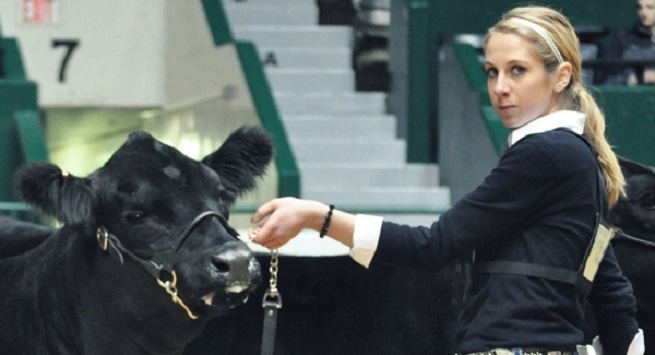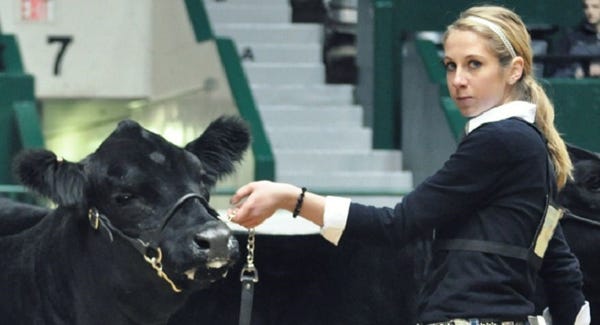Showing Cattle Is More Than Ribbons And Banner

It’s not all about the shining trophies, purple ribbons, or champion plaques. It takes numerous hours in the barn, endless chores, daily washing, regular exercising, blood, sweat, and tears to raise a champion animal. Every minute of every day’s effort leads to one brief appearance in the show ring with the outcome resting in a single judge’s opinion. Perhaps the paradox, and reward of showing livestock is that a showman has so much, yet in the end so little, control of the outcome in the ring.
Judging by what we see in media, competition seems to be craved in today’s society. Still, in American culture, friendly competition has been replaced with the mantra that “everyone is a winner.”
According to USA Today, “We have built a handholding fantasy culture that is leaving our children unprepared for the ups and downs of life. … Without competition we are a nation of underachievers. It is time our country and our kids get back to winning and losing on the playing fields and failing and honor-rolling in the classroom. Our fun run approach to life is weaning future generations off of guts, fortitude, discipline, risk taking, confidence and other critically important ingredients for achievement.”
Today, it seems that in order for a child to have any success in their future sports career, they must begin playing by the time they can walk. When children pursue athletics at such an early point in their life, their performance often peaks prematurely or they become bored with the sport before they can earn college scholarships.
Showing livestock is different, in that it can be pursued by anyone at any time; as success is ultimately determined by effort over experience. Growing up playing multiple sports, I can testify that my inner competitor has surfaced most through showing livestock.
In my senior year of high school, I decided to ditch the basketball court and dedicate that time to the barn where my effort would prove to be more beneficial to my future. Plus, showing livestock serves as both an individual and team activity. While an exhibitor plays a major role in their own success, guided encouragement from family, FFA/4-H club, friends, and supporters contribute encouragement to guide them along; thus serving as the most cohesive “sport” there is.
�

Ribbons Fade Over Time, But Lessons Learned Remain
If you grew up showing cattle or judging livestock, you probably weren't even aware at the time about all the lessons you were learning while attending all those practices and contests. Read about the invaluable lessons learned here.
Sportsmanship is taught through tough competition. An exhibitor learns how to be a humble winner as well as a gracious loser. There are no “completion points” nor “A’s for effort” rewarded in the ring. Taking initiative by implementing learned showing techniques, selecting superior genetics, utilizing smart feeding programs, and caring for their animals ethically, an underdog can rise to the top relatively quickly. There are no number-one seeds in a livestock arena. While there are exhibitors whose livestock perform time and again, the spotlight remains available for anyone who is willing to work for it.
Responsibility is not as much taught, as it is instilled, on the farm. Dedication 365 days out of the year teaches production management skills to all who are involved. Diseases seem to creep into the herd when least expected, and I’ve learned basic handling and antibiotic treatment to administer to sick livestock. My involvement in Quiz Bowl and General Livestock Judging teams has allowed me to apply the production knowledge and industry awareness that I have learned by selecting superior genetics to implement into our own breeding program at home.
What’s more, financial responsibility has been practiced through capital assets (aka cattle, lambs, and hogs) that I have invested in. Unfortunately, I have also learned that agriculture does not guarantee financial reimbursement. Every animal, vet visit, and bag of feed, adds up; and market prices are often unpredictable. But even with the attached expense, the experience has taught me money management and entrepreneurship.
Because animal agriculture is dense with risk, it is beneficial to have a supportive family nearby. Faith ties families together in dealing with distress. Losing livestock that have received unconditional attention and served as a livelihood is difficult. On the farm, I have learned how to cope with death as well as welcome new life into the world.
Self-drive, honesty, and integrity are the final skills that define youth livestock exhibitors as “cream of the crop.” Thomas Edison said, “Opportunity is missed by most when it comes dressed in overalls and looks like work.” Most farm kids portray an undoubtedly hard work ethic and persistent demeanor. We are not afraid to get our hands dirty in order to gain the results we envision.
Entering the show arena signifies the end of a show season’s long hours of preparation. At the same time, it is just the beginning – where hard work meets opportunity. As a 19 year old, my seemingly infinite years of 4-H will come to an abrupt end this summer. Looking back over the countless dairy cattle, beef cattle, market lambs, and market hogs that I have trained over the past 13 years, I do not view any one of them as “a waste of time.”
Showing livestock has been the foundation of the many skills that I have learned and has projected a bridge into my future. Due to my appreciation for animal agriculture, I am pursuing a degree in agricultural education – communications and leadership, with minors in animal science and agriculture and food business management, at the University of Minnesota.
“You get out what you put into it” is an understatement in the midst of agriculture. When it comes to showing livestock, an individual not only reaps physical reward at shows, but more important, gains underlying skills that will never be replaced. Livestock show enthusiasts truly are purple ribbon people.
You Might Also Like:
10 Signs You Grew Up On A Farm
Tips For Minimizing Heat Stress In Cattle
How To Treat Pinkeye In Cattle
Pasture Management: Better Forage Through Proactive Blackberry And Thistle Control
About the Author(s)
You May Also Like


.png?width=300&auto=webp&quality=80&disable=upscale)
